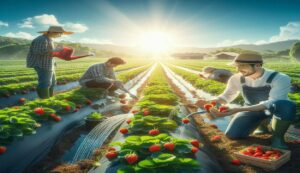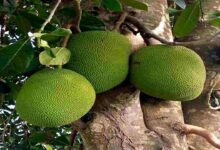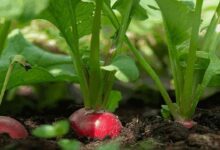Strawberry cultivation: Beginners should follow this guide for strawberry cultivation
Strawberry cultivation: Fragaria x ananassa is the scientific name for strawberries, which are members of the Rosaceae family. Growing strawberries is important for the economy and for agriculture. These berries are not only tasty but also nutrient-dense and essential for encouraging a balanced diet. Since strawberry plants are herbaceous perennials, they will repopulate every year. These berries are a favorite among gardeners since they grow well in a variety of conditions.

Soil Preparation
The key to successful strawberry production is prepared soil. Plants will get the nutrients they need to flourish if the bed is prepared properly. To determine the pH and nutrient levels in the soil, start with a test. Strawberries thrive on soil that is slightly acidic—ideally, pH between 5.5 and 6.8. As necessary, amend your soil by adding sulfur or lime.
Adding organic stuff strengthens the structure and increases fertility. Old manure may encourage healthy microbial activity and provide vital minerals. A loose, aerated environment is created for root growth by proper tilling. To reduce nutrient depletion and interrupt pest cycles, think about crop rotation techniques. Strong plants are supported by healthy soil, which also results in increased yields throughout the year.
Concerns with Watering
Watering strawberries is a difficult task. There might be major issues if there is too much or too little. Overwatering is a typical error. It rots the roots by suffocating them. Plants lose production when they are susceptible to illnesses. Yellowing leaves and plants that are withering in spite of damp soil are symptoms. Conversely, underwatering reduces fruit quality and inhibits development. Consistent moisture is necessary for strawberries, particularly during blooming and fruit development.
Dried weather produces smaller, blander fruit. Sustaining strawberry plants requires careful attention to soil moisture levels. It’s time to water again if the top inch feels dry, as determined by a quick finger test. Systems for drip irrigation are great ways to save waste and maintain ideal moisture levels. Achieving the ideal balance guarantees that healthy and productive plants remain lively until they are ready for harvest.
Handling Typical Strawberry Insects
One of the most infamous obstacles in strawberry production is dealing with pests. Preventing these unwanted visitors is essential for a robust harvest. Particularly troublesome are aphids. These microscopic insects cause stunted development and lower harvests by sucking sap from plants. And then there are spider mites, which like dry, hot weather. If they are not checked, their webbing may suffocate strawberry plants.
As much as we do, slugs and snails also like strawberries. On moist evenings, they usually feast on new leaves and juicy fruit. Additionally, do not underestimate the harm presented by thrips. They destroy fruits and blossoms, leaving scars that reduce the fruits’ marketability. In order to keep your strawberries growing and unharmed, effective pest management methods include routine monitoring and integrated techniques that combine biological treatments with organic insecticides as needed.
Prevention and Management of Illnesses
Many diseases that afflict strawberry plants may have a major effect on production. Effective control of these hazards depends on early detection. Powdery mildew is a widespread disease that causes white, powdery patches on leaves. This fungal infection grows best in warm, humid environments. Botrytis fruit rot, which results in gray mold on mature strawberries, is another reason for worry. This often happens in rainy conditions and, if left untreated, may spread quickly.
Foliage that is attacked by fusarium wilt becomes yellow and wilts as a result. Regrettably, in order to stop the infection from spreading, plants may need to be completely destroyed once affected. Alternaria leaf spot may lower the efficiency of photosynthesis and appears as black lesions on leaves. Frequent observation helps in identifying these problems before they become worse. Timely fungicide treatments may help successfully limit damage when infections do occur.
Temperature control and protection against frost
Strawberry harvests are vulnerable to frost, particularly at key development stages. Harvesting strawberries successfully depends on shielding them from sudden decreases in temperature. Using row coverings is the best course of action. The plants are surrounded by a microclimate that is produced by these airy textiles trapping heat. This way gives them some shade on hot days in addition to protecting them from frost.
An other method is to use irrigation with water just before the temperature drops. Heat is released as water freezes, forming a barrier that keeps frost damage at bay. Keeping an eye on weather predictions is also very important. Staying aware of approaching cold snaps allows farmers to protect their crops in a timely manner.
Controlling Weeds
With weeds fighting for nutrients and moisture, weed cultivation may provide serious challenges. Good management is necessary to guarantee robust plants and large yields. One of the best techniques is mulching. Organic mulches help retain soil moisture better while also suppressing weeds. Hand weeding on a regular basis is critical as well. Even though it takes a lot of work, growers may precisely target undesired plants without upsetting the strawberries using this method.
Herbicides, especially pre-emergent varieties that stop weed seeds from sprouting, may also be effective. However, in order to protect strawberry plants, treatment must be done carefully. By upsetting the development cycles of weeds, crop rotation provides an additional line of protection against weeds that persist. In addition, reducing weed establishment and preserving soil health are two benefits of growing cover crops during off-seasons.
Issues with Pollination and Their Remedies
With weeds fighting for nutrients and moisture, weed cultivation may provide serious challenges. Good management is necessary to guarantee robust plants and large yields. One of the best techniques is mulching. Hand weeding on a regular basis is critical as well. Even though it takes a lot of work, growers may precisely target undesired plants without upsetting the strawberries using this method.
Herbicides, especially pre-emergent varieties that stop weed seeds from sprouting, may also be effective. However, in order to protect strawberry plants, treatment must be done carefully. By upsetting the development cycles of weeds, crop rotation provides an additional line of protection against weeds that persist. In addition, reducing weed establishment and preserving soil health are two benefits of growing cover crops during off-seasons.
pH of Soil and Deficiencies in Nutrients
The pH of the soil is important for growing strawberries. It affects the availability of nutrients, which impacts the uptake of vital minerals by plants. The ideal soil for strawberries is somewhat acidic. Nutrient deficits may occur when the pH departs from this range. For example, iron and manganese become less accessible if the soil is excessively alkaline. Symptoms such as yellowing leaves or slowed development result from this.
Maintaining an eye on pH levels and nutrient condition requires regular soil testing. It’s critical to maintain an appropriate supply of nutrients like potassium, phosphorus, and nitrogen in addition to controlling pH. Compost and other organic amendments improve the soil and provide helpful bacteria that promote plant health.
Maximize growth must use mulching
Growers of strawberries who want to maximize growth must use mulching. In order to produce a protective layer, it entails overlaying the soil with artificial materials. A common choice is straw mulch. It contributes to the suppression of weed development, which helps strawberries thrive. Additionally, when it breaks down, it progressively nourishes the soil.
Mulch made of plastic has also become popular. It comes in a variety of colors and works to regulate temperature changes to warm the soil and improve fruit output. Black plastic is very good at reflecting sunlight onto plants and keeping weeds at bay. There are advantages to using organic substitutes like wood chips or crushed leaves. Over time, they enhance soil structure and encourage the growth of advantageous microbes that maintain plant health.
Harvesting Difficulties: Strategies and Timing
Timely harvesting of strawberries is essential for optimal quality and taste. Berries that are picked too early may taste sour, while those that are left too long may rot and overripen. Farmers need to monitor their farms carefully. Methods differ greatly from one another. The best method is still hand-picking, which enables meticulous selection of ripe fruit.
Nonetheless, during the busiest harvest seasons, machinery may expedite the procedure. Every approach has benefits and drawbacks. Harvesting tactics are also greatly influenced by weather conditions. The mold on newly harvested berries may grow faster in the rain or in high humidity, so time is even more important.
Post-Harvest Handling and Storage
In strawberry cultivation, post-harvest management is an essential stage. Strawberries are very perishable after picked and need to be treated right once. Their shelf life may be considerably increased by using proper cooling procedures. Lowering the temperature quickly aids in preserving taste and freshness. But these fragile fruits might bruise or rot if not handled carefully.
The state of storage is also very important. Close monitoring of humidity levels is necessary to avoid excessive dryness, which may lead to dehydration, and to stop the formation of mold. Packaging is also important. Using permeable containers keeps strawberries appearing desirable to customers by allowing air circulation without retaining moisture within. Concerns around transportation must also be considered by farmers. When long distances are not handled well, quality might suffer. Assuring rapid transit times will contribute to maintaining the fruit’s quality till it is stocked on store shelves.
Price volatility and fluctuations in the market
Lower pricing might result from an excess of strawberries during peak seasons. On the other hand, unfavorable weather or insect infestations may reduce harvests and increase expenses. For farmers, this volatility makes planning challenging. Furthermore, strawberries are now competing globally rather than simply regionally due to the growth of international markets. International producers who may sell their goods at cheaper prices are now a competitive threat to farmers’ prices.
Farmers need to keep up with market developments so they may modify their tactics as necessary. Having a solid rapport with wholesalers might help you negotiate better prices even in times of uncertainty. Comprehending these obstacles is vital for prospering in the constantly evolving terrain of strawberry cultivation. In these situations, marketing strategy adaptation is crucial. Increasing the variety of products offered or cultivating ties with regional markets might assist stabilize revenue in erratic times. For strawberry farming to be successful in the long run, it is important to understand market trends.
Difficulties in Distribution and Transportation
Strawberries have a limited shelf life after harvest, thus action must be taken quickly. Farmers must overcome logistical challenges in order to promptly deliver their fresh product to market. Profits may be greatly impacted by spoiling, which might occur due to delays. Because strawberries are sensitive, they must be handled carefully while in transportation. Selecting the appropriate modes of transportation is essential. Refrigerated vehicles have significant operating expenses but aid in maintaining freshness. For many farmers, striking a balance between cost and efficiency becomes a difficult issue.
Distribution networks also need to be well-coordinated. Farmers sometimes depend on middlemen who may not handle the produce with the utmost care or quickness. Damaged items may make their way to customers or merchants as a consequence of this gap. Delivery times and road accessibility are also impacted by weather conditions. In order to effectively get their berries into the hands of hungry consumers, growers must overcome these obstacles with strategic planning and creative solutions.
Logistical challenges, such as poor transportation infrastructure, are common for farmers. Access to refrigerated transportation and dependable roads may be scarce in rural places. This raises expenses and degrades the quality of the product when it is delivered to customers. The scheduling of delivery is another ongoing difficulty. Due to their limited shelf life, strawberries must be scheduled exactly from the farm to the market. Any error might undermine their attractiveness. The state of the weather exacerbates the situation. Extreme heat or rain may mess with transportation plans and reduce the effectiveness of the supply chain as a whole.
Manpower Scarcities and Workplace Administration
A lot of farmers have trouble finding and keeping qualified labor during busy times. Potential workers may be turned off by the work’s seasonal nature. In addition, there are often fewer workers available for planting and harvesting due to rivalry from other businesses. Managing the staff effectively becomes essential to addressing these issues. Encouraging people to join the team with competitive pay and perks may help.
Training initiatives are crucial in providing employees with the skills they need. Putting money into staff development increases productivity and cultivates loyalty. Scheduling flexibility can potentially draw in more applicants. An operation might become more enticing by realizing that many job searchers aim for a balance between their personal and professional lives. Working together with nearby educational institutions or career centers might facilitate the development of a pool of prospective employees prepared to join the industry. Taking this proactive stance is crucial to obtaining a trustworthy workforce.
Effects of Climate Change on Strawberry Production
Temperature increases may affect yields by changing the timing of blooming and fruiting. Unpredictable weather patterns are a common challenge for farmers. Rainfall increases have the potential to cause soggy soil, which may harm plant roots and increase their susceptibility to disease. On the other hand, plants under stress due to a drought may produce smaller and lower-quality fruits.
In addition, bugs usually prefer warmer temperatures. This adds another level of complication as farmers have to constantly modify their pest control plans. Growers are investigating cutting-edge methods like climate-resilient cultivars and sophisticated irrigation strategies to address these problems. By using these techniques, we want to increase resistance to the changing environment and make sure that strawberries are a sustainable crop for coming generations.
Growing strawberries brings with it a special set of difficulties that need for cautious handling and creative solutions. However, strawberry producers may overcome these obstacles and go on offering customers wholesome and tasty strawberries with careful preparation, the use of successful tactics, and flexibility.

